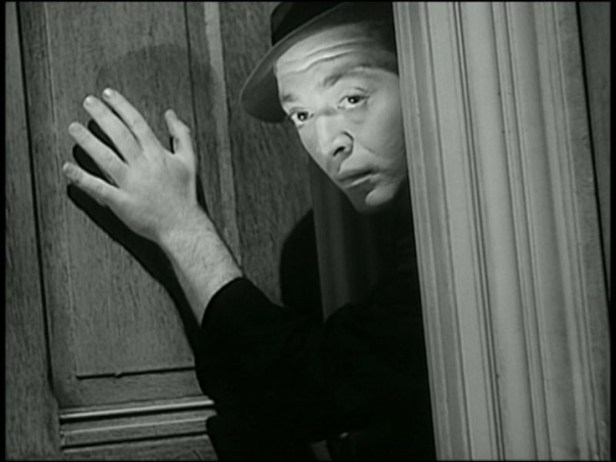Michael Ward (John McGuire) is a newspaper man. He’s got a good life: front-page bylines, a recent pay raise, and he’s engaged to a beautiful woman named Jane (Margaret Tallichet).

Michael arrives at a diner and tells Jane the reason for his raise: he’s a key witness to a murder case, and he’s helped send Joe Briggs (Elisha Cook, Jr.) to death row after seeing Briggs fleeing from a murder scene. He’s got the biggest scoop of the year, and has raised the reputation of himself and his publication.
Jane isn’t so sure that Briggs is guilty, and she expresses her doubts to Michael. While he was certain enough to take the stand at Briggs’ trial, Michael begins to reflect on the series of events that led to Briggs’ arrest… and he begins to believe that Jane may be right, especially after he witnesses a second murder, at the hands of a stranger (Peter Lorre).
Boris Ingster directs 1940’s Stranger on the Third Floor, a quick little crime drama from RKO.
Though only a minor noir picture — a piece of hay in the haystack of the genre, rather than a more-desirable needle — Stranger on the Third Floor has a few very striking scenes. In one scene, Elisha Cook, Jr. (brilliant character actor) proclaims his innocence from the courtroom stand. His screams fall on deaf ears, as the rest of the room remains silent.
Another sequence, the film’s absolute best, is a horrifying and surreal nightmare experienced by Michael. In this dream he finds himself accused of murder. He’s interrogated by a group of angry men; Jane turns her back on him, not sure whether to believe his innocence; he’s assigned a lawyer who only laughs when he claims he’s innocent; the entire jury sleeps through his trial. Essentially, Michael is put in Briggs’ shoes.
Aside from the handful of above-average emotional and suspenseful scenes, the biggest draw for viewing this film is an appearance by the fantastic Peter Lorre, in all of his bulging-eyed, effectively-creepy glory. No one else could have played “the stranger” quite so well. His appearance is relatively brief and he’s not given a whole lot to do, but he leaves a much larger impression on the viewer than any other member of the cast!
On one more positive note, the photography of Stranger on the Third Floor is very nice. In particular, each scene is beautifully lit, with high contrast and plenty of shadows. This is one of many Hollywood films in which a clear German expressionist influence can be seen, and the execution of that influence is very effective here.

Stranger on the Third Floor isn’t the best noir you’ll ever see, but it has its fair share of positive attributes. It’s played a bit over-dramatically, with its stunning-but-stark photography, loudly theatrical score, and narrated flashbacks… but I kind of love the fact that it isn’t afraid to go over-the-top. Overall, I enjoyed it, and with a run-time of just over an hour, it makes for a nice little afternoon diversion. The score: 4/5
Many have said that this is the first true noir film; since I’ve never seen it, I’ll have to stick with ‘The Maltese Falcon’ for now. But I really need to check this one out, if only for Peter Lorre. And to prove whether or not it’s indeed the first!
LikeLike